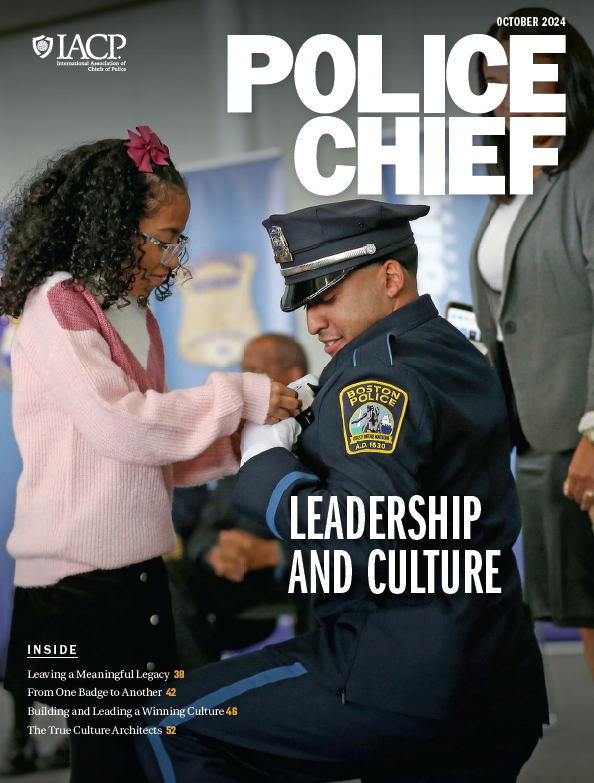Police officers have always been jacks of all trades. The United States did a very good job promoting the use of 911 since the first call was made on February 16, 1968, and those three simple numbers have become the first, and often only, call for assistance in the United States when help of any type is needed.1
Police are summoned to criminal and noncriminal situations alike with the expectation that they will render an amenable solution and “fix” the issue. The problem of late has been that all too often, the public becomes critical (and rightly so, in many cases) of police actions taken, especially when dealing with special populations. Perhaps the problem is that too much has been asked of police for too long.
As the saying goes, “when all you have is a hammer, every problem looks like a nail.” Almost unanimously, officers take an oath “to help people” when they sign up for the job. They are well-intentioned, conscientious individuals that have a real desire to help people in their worst moments. They are taught the laws of the land, local statutes, and how to keep communities safe. Police have been using arrest as the major tool for doing this, depending on the hammer of the criminal justice system to take care of problems. Historically, police have relied almost completely on that hammer, but recently, they have been asked to handle more complex problems. However, often, police officers are not adequately trained and have not been given the appropriate tools to respond to these more complex problems.
In the 1990s, community policing was a popular police strategy. Police were taught how to connect with their communities—to use the strategy of community policing to form community partnerships and to proactively address the problems and social issues that give way to public safety issues. Training took place at the academy level and during in-service trainings, and stand-alone community policing seminars were launched throughout the United States. Officers were trained in the SARA model of community policing: Scanning, Analysis, Response, and Assessment. They were trained to identify and correct conditions that could lead to crime, raise community awareness, and engage the community in finding solutions to problems.2 While the process itself is important, of more importance is the fact that extensive training was provided. Police were taught and understood the process as well as the desired end result, and they used the provided philosophy to solve the problem.
Fast forward to the 21st century. In 2010, the state of Delaware voluntarily entered into a consent decree with the United States Department of Justice (DOJ).3 There was an investigation at the Delaware Psychiatric Center (DPC), the state’s sole psychiatric hospital, alleging misconduct and unnecessary hospitalizations of individuals with serious and persistent mental illness (SPMI). Delaware’s Department of Health and Social Services, Division of Substance Abuse and Mental Health (DSAMH) agreed to develop and provide community-based services to individuals with SPMI diagnoses who were being released from the DPC. Along with other mandates, the DOJ also wanted psychiatric mobile crisis teams (MCTs) to work alongside of trained police officers who might have regular contact with these individuals in the community.
Mobile Crisis Response and Co-responders
The plan was to have MCTs available to respond with police when encountering the recently released DPC residents in the field.
Mobile crisis responders had been working loosely with the police for years, but under the consent decree, Delaware needed to develop an organized, routine protocol. The Mobile Crisis Services team at DSAMH worked with community stakeholders to develop a curriculum for crisis intervention team (CIT) training and began training Delaware law enforcement in how to help individuals experiencing a behavioral health crisis. The 40-hour training was an eye-opener for many officers and gave them a significant look into the world of behavioral health disorders. While CIT is a great start, it barely scratches the surface in covering the range of experiences police may encounter in the field when dealing with individuals in a behavioral health crisis. This marked the beginning of Delaware law enforcement’s introduction to the rapidly evolving behavioral health system.

In 2014, MCTs began to accompany officers in the field when the police needed support in dealing with an individual experiencing a behavioral health crisis. Over the next several years, trust was built between the MCTs and police, and agencies began to call crisis teams on a more regular basis, sometimes asking for assistance over the phone if the teams were unable to respond in person.
In 2018, the New Castle County Police Department (NCCPD) had expressed an interest in having a clinician on loan to launch a true co-responder model. Working with a community-based service provider that was amenable to this work, they were able to get a clinician assigned to begin working with the department. Within several months, Centers for Medicare and Medicaid Services grant money became available and was used to place a clinician with the Smyrna Police Department. Several months after that, another small pot of grant money became available from DSAMH, and a clinician was assigned to work with the Georgetown Police Department, which was willing to try out the program. Most recently, the Milford Police Department has contracted for an embedded clinician and started its own program. With these partnerships in place, police agencies throughout Delaware are experiencing the benefits of a true co-responder model program first-hand.
Case Study: Smyrna Police Department
The Smyrna Police Department was cautiously optimistic about the prospect of having someone assist with their “frequent flyer” calls that they just couldn’t seem to get a handle on. Chief Torrie James focused on addressing those calls that his officers knew were nuisance calls, not truly criminal in nature, but that officers did not know how to best remedy.
Chief James says that statistics prove that if officers give a suspect an option to come to the police department the next day to get help, many would not pursue that option. He stresses that the addition of Jim Deel, the clinician assigned to the Smyrna Police Department, has been invaluable.
“What Jim brings to this department is the ability to have an individual assessed immediately. We don’t have a nearby hospital—my officers have to (transport) individuals from Smyrna to Dover, and sometimes they have to sit in the emergency room for hours,” Chief James said. “Jim goes from Point A to Point B, and we skip that middle portion, so he saves us a lot of time and energy.”4
We all know that right now that the world of policing has changed and there’s no more arresting ourselves out of an issue. We have learned to ask ourselves the question of why, “Why…. why are we continuing to come out to this house? Why are we continuing to deal with this individual?” What we have now is Jim… a resource. Jim is in the car with the officer, and he is the person that is there to give an individual the opportunity to get the help that they need—and immediately.
In addition to providing that immediate support, Deel can also help in making referrals to services that individuals may need or assist folks in getting in contact with a provider that they may have lost touch with. “We get phone call after phone call about people that really need him,” Chief James said. “Jim is doing it one person at a time, and he has definitely made a difference in this town.”
Police officers routinely struggle with the stressful decision of whether to arrest someone who is in the throes of a mental health–related crisis. That is where Deel takes over and provides connections that will take the individual directly to a mental health facility in search of treatment rather than to an expensive emergency room. Most often there is a component of follow-up with many of these individuals as they struggle to go on with their lives and gain a sense of normalcy. This model allows police to get individuals referred to a community provider who can get the person in crisis the help that he or she desperately needs while still maintaining public safety. Officers are comfortable with Deel; he has become a trusted colleague to discuss client concerns and make referrals to the best level of care for these individuals in lieu of or in addition to arrest action. As a result, officers feel like they are staying true to their oath of helping those that they serve.
When Deel speaks about working alongside members of the Smyrna police, you can hear the pride in his voice, as he is now considered part of the team there. “I can see the impact with my interactions with the officers,” he says. “Most everybody in Smyrna has really welcomed me, and it seems to be a good fit. We work well together as a team to address the concerns within the community.”5
Additional Tools
 While not all calls end with a quick solution, the clinicians that have been working with the agencies have maintained contact with many of the individuals, providing them with much-needed case management services and the ability to “check in” as necessary. In Delaware, this model has given three police departments the additional tools they need to better help individuals with behavioral health and substance use concerns access treatment at the time of police contact. Individuals are able to have a conversation with someone who is not wearing a police uniform and who may have a better understanding of their concerns. All the while, police are getting a hands-on view of strategies to assist individuals with behavioral health needs more appropriately and a better understanding of the disorders some community members experience. While this model is not perfect and not for all agencies, these departments now have a more diverse toolbox to handle calls that they are routinely being dispatched to.
While not all calls end with a quick solution, the clinicians that have been working with the agencies have maintained contact with many of the individuals, providing them with much-needed case management services and the ability to “check in” as necessary. In Delaware, this model has given three police departments the additional tools they need to better help individuals with behavioral health and substance use concerns access treatment at the time of police contact. Individuals are able to have a conversation with someone who is not wearing a police uniform and who may have a better understanding of their concerns. All the while, police are getting a hands-on view of strategies to assist individuals with behavioral health needs more appropriately and a better understanding of the disorders some community members experience. While this model is not perfect and not for all agencies, these departments now have a more diverse toolbox to handle calls that they are routinely being dispatched to.
In the 10 years since the consent decrees, the NCCPD’s program has evolved into the HERO HELP program, the clinician assigned to the Smyrna Police Department (Jim Deel) is still on staff, and the Georgetown Police Department has contracted independently for its clinician to stay on after the initial grant was exhausted. The National Alliance of Mental Illness of Delaware is still providing CIT training, along with Veteran’s Response Team training, which is focused on helping veterans experiencing behavioral health crises.
Notes:
1“First 911 Call Is Made in the United States,” History.com, November 5, 2019.
2U.S. Department of Justice (DOJ), Office of Community Oriented Policing Services, Community Policing Defined (2014).
3DOJ, “United States v. Delaware,” February 25, 2016.
4Mike Finney, “Dover PD Looks to Put Mental Health Clinicians in Police Cars,” Bay to Bay News, October 21, 2020
5Finney, “Dover PD Looks to Put Mental Health Clinicians in Police Cars.”
Please cite as
Amy Kevis, “Staying True to the Oath: Delaware’s Co-Responder Model Helps Officers Help Others,” Police Chief Online, April 28, 2021.



